crimson erineum mite
(Aceria elongata)
Conservation • Description • Habitat • Biology • Distribution • Taxonomy
|
|
|||||||||||||
Description |
At only one tenth the width of a human hair in length, a crimson erineum mite (Aceria elongata) is barely visible to the human eye unaided by magnification. Its claws, dorsal shield markings, and other identifying body features are not. Identification in the field is possible only by noting the properties of the abnormal growths (galls) it produces on its host. When an individual leaf cell is injured by a mite, it produces a small, nipple-like projection (papilla) on the upper surface of the leaf. The papilla has a rounded tip, visible only with magnification, and is filled with colored fluid. As the mite feeds on adjacent cells, the aggregation of papillae forms a pustule-like, felty patch (erineum). The erinea are usually scattered over the leaf surface, thickest toward the upper (apical) half, and avoiding the major veins. They are greenish-white at first, soon becoming crimson or purplish. They reach their maximum extent, and are most noticeable, in summer. The infestation is sometimes abundant and can cause leaf distortion and premature leaf drop. |
Size |
Total length: 0059″ to .0085″ (150 to 216 microns) |
Similar Species |
Habitat and Hosts |
Sugar maple and possibly also black maple |
Biology |
Season |
Galls visible from early spring to fall |
Behavior |
|
Life Cycle |
The life cycle of the crimson erineum mite involves alternating generations and is adapted to seasonal changes in the host. Overwintering females emerge in early spring from bark where they spent the winter. The migrate to newly developing buds and ride out on new leaf growth. They begin feeding, enter the resulting galls, lay eggs, and die. In late spring and early summer the eggs in the galls hatch, producing white male and female mites (protogynes). In mid-summer, red female mites (deutogynes) are produced. They fill the galls, obscuring the white protogynes. In September, these female deutogynes migrate to bark crevices in stems and twigs, where they will spend the winter. |
Damage |
The infestation can cause leaf distortion and premature leaf drop when abundant. |
Distribution |
||
|
Sources |
|
| 6/12/2025 | ||
Occurrence |
||
Common in Eastern North America |
||
Taxonomy |
|
Class |
|
Subclass |
Acari (mites and ticks) |
Order |
Acariformes (mites) |
Superfamily |
Eriophyoidea |
Family |
Eriophyidae (gall and rust mites) |
Subfamily |
Eriophyinae |
Tribe |
Aceriini |
Genus |
Aceria |
Order |
|
Subordinate Taxa |
|
|
|
Synonyms |
|
Eriophyes elongatus Eriophyes regulus Eriophyes roseum |
|
Common Names |
|
crimson erineum mite |
|
Glossary
Erineum
A type of plant gall. An abnormal, felt-like growth of hairs on a leaf surface caused by a mite, especially Eriophyes. Plural erinea.
Gall
An abnormal growth on a plant produced in response to an insect larva, mite, bacteria, or fungus.
Papilla
A tiny, rounded, nipple-like projection on the surface of a leaf or petal.
Visitor Photos |
||
Share your photo of this arachnid. |
||
This button not working for you? |
||
|
||
MinnesotaSeasons.com Photos |
||
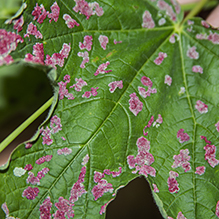 |
||
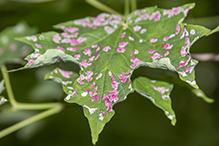 |
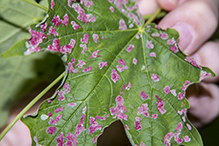 |
|
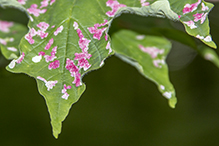 |
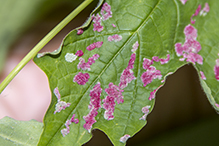 |

Slideshows |
|

Visitor Videos |
||
Share your video of this arachnid. |
||
This button not working for you? |
||
|
Other Videos |
||
|

Visitor Sightings |
||
Report a sighting of this arachnid. |
||
This button not working for you? |
||
|
|
MinnesotaSeasons.com Sightings |
||

Created: 3/30/2018 Last Updated: © MinnesotaSeasons.com. All rights reserved. |
